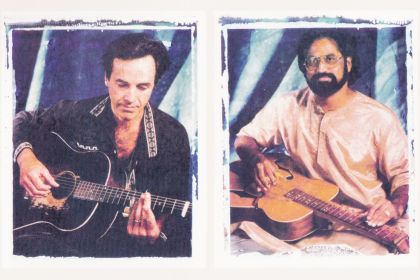SITAR
1960s clarinet & sitar duo pioneered an ambient genre with the album for spiritual practices

Music for Yoga Meditation and Other Joys by Ronald Walotsky
Music Period: 1960s
Genre: Ambient
Artist: Tony Scott, Collin Walcott
Album: Music for Yoga Meditation and Other Joys
Even though the term ambient as a music genre was coined by Brian Eno only in the 1970s, musical experiments of this particular variety began as early as the Romantic era with French pianist Erik Satie composing his famous Gymnopédies and laying the groundwork for the main principles of background music.
The massive success of ambient music in the 1980s is tied to the trends shifting rapidly towards synthesizers in popular culture, but back in the 1960s, in the era of new electric guitar sound, first albums of background music were mostly sought out by the flower power generation for clearing the mind during spiritual practices. A great example of this meditation-oriented genre is Music for Yoga Meditation and Other Joys, a 1968 album that mixed the core concept of ambient with Indian classics and conceived by two American jazz musicians Tony Scott and Collin Walcott.
After releasing more than a dozen jazz records in the 1950s, Tony Scott devoted himself to cross-cultural experiments by traveling the world in search of fresh harmonies for his clarinet. His many collaborations with folk musicians in India, Japan, and Southeast Asia resulted in several truly revolutionary albums that provided an appropriate atmosphere for spiritual practices that were gaining substantial popularity in the West.
To record Music for Yoga Meditation and Other Joys, Tony Scott collaborated with jazz multi-instrumentalist Collin Walcott who by then had mastered the sitar under the guidance of Ravi Shankar and fused Indian classical elements with Western pop culture with the band Oregon.

Although Music for Yoga is imbued with Indian traditions, it cannot be strictly considered a classical Indian raga since it does not contain important elements of this musical form. Nevertheless, both Scott and Walcott demonstrated melodic flexibility in their exploration of the Indian classic scales, making it more accessible for Western listeners.
Listen to Hatha by Tony Scott & Collin Walcott from 1968 Music for Yoga Meditation and Other Joys:
Recorded as one continuous half-hour long track, the album was later divided into ten parts during production which is somewhat inconvenient for the meditation purposes prescribed in the title and, most likely, was done per demands of the label.
Listen to Triveni by Tony Scott & Collin Walcott from 1968 Music for Yoga Meditation and Other Joys:
It should be noted that many progressive bands of the time faced similar restrictions and were forced to present a concise list of tracks on album covers even if an entire side of an LP was reserved for one long track. For example, during the production of the Atom Heart Mother suite, Pink Floyd was forced to invent titles for the sub-parts of the track at the request of the publisher.




I've been looking for this album for years... I heard a couple of tracks from it in a chill out room in a club back in the early 90s, but I never did find out who'd recorded it. No amount of searching that involves the words 'clarinet and sitar' has ever turned this up in a web search, and it got to the point where I began to think that I might have conjured the whole thing up in a drug fuelled haze!